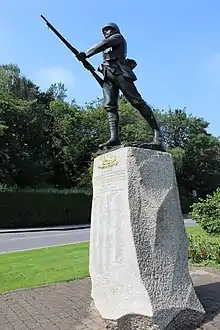Onslow Whiting
Onslow Ernest Whiting (4 June 1872 – 4 August 1937)[1] was an English sculptor and teacher.
Born in Shoreditch,[2] from 1901 to 1927 Whiting worked as a teacher at the Central School of Arts and Crafts in London.[1] The sculptor Cecil Thomas was among his pupils.[3] His best known works are war memorials. The Gloucestershire Regiment Memorial, Queen's Road, Bristol was listed in 1977. It commemorates the Boer War and consists of a bronze figure of a soldier on a granite plinth. It was unveiled by Earl Roberts in 1905.[4] The bronze was cast by the Parlanti Foundry of London.[5]The Letchworth Cross at Station Place, Letchworth, where Whiting went to live in 1905, commemorates the fallen of the First World War and was unveiled in 1921 by Viscount Hampden.[6] It was listed in 2013.[7] Whiting also created three relief panels for the obelisk commemorating the South African War in Plymouth, on Plymouth Hoe, a gift from Alfred Mosely, the philanthropist who had made his fortune in South Africa. The panel facing north shows the spirited charge of the Devonshire Regiment at Waggon Hill and is inscribed with the words: "One point in our position was occupied by the enemy the whole day but at dusk in a very heavy rainstorm they were turned out of the position at the point of the bayonet in the most gallant manner by the Devon Regiment led by Colonel Park. General White's despatch 7 January 1900." Another panel shows the Somerset and Gloucestershire Regiments in action. The last panel carries the inscription: "This obelisk is erected by Alfred Mosely to the memory of Christian Victor Prince of Schleswig-Holstein and to the officers, non-commissioned officer and men of the Gloucestershire, Somerset and Devonshire Regiments who fell during the Boer War, 1899-1902. Onslow Whiting. November 1902."[8] Whiting carried out another commission for Mosely in 1906 when he created a large bronze plaque to the memory of Mosely's long-standing friend Cecil Rhodes, who died in 1902 at the age of 48. The plaque is fixed to the facade of a terrace of houses from the 1870s which belongs to Oriel College, and marks the house where Rhodes spent the Michaelmas Term of 1881. Rhodes had matriculated in 1873 and returned to South Africa twice during that period, where he established himself in the mining industry and was elected an MP in the Cape Parliament. His tutor persuaded him to return to Oxford, where he sat Finals and took his degree.[9] Whiting made an effort to integrate the plaque into the architecture of the terrace and lined it up with the windows to create the effect of another window. The plaque is aedicular in shape and contains a relief portrait bust of Rhodes, with the arms of Oriel College, three lions on a shield above, and below him the inscription, '‘IN THIS HOUSE THE RIGHT HON. CECIL JOHN RHODES KEPT ACADEMICAL RESIDENCE IN THE YEAR 1881. THIS MEMORIAL IS ERECTED BY ALFRED MOSELY IN RECOGNITION OF THE GREAT SERVICES RENDERED BY CECIL RHODES TO HIS COUNTRY.’
Whiting was a member of the Royal Society of British Sculptors and the Art Workers Guild and an Associate of the Guild of Art Craftsmen.[10]
Whiting created many sculpture panels in metal as well as architectural metalwork. A panel entitled St George and the Dragon was exhibited in 1899 at the sixth exhibition of the Arts and Crafts Exhibition Society.[11] He exhibited a letter-plate entitled Mercury at the exhibition of 1910, where it was for sale for £3 3s.[12] His door knocker Prometheus Bound was shown at the Spring Exhibition of the City Art Gallery, Leeds in 1897 and was for sale by commission in bronze for £10 10s. The sculpture panel A Dream was also shown at this exhibition.[13]
Three of his works were published in the journal Academy Architecture and Architectural Review. Field Guns Going into Action (vol. 20 (1901) 85) is a metal relief sculpture showing a vivid battle scene from the Boer War. His Designs for Bell-pushes, Finger-plates, etc. (vol.20 (1901) 87) make creative use of human figures in architectural hardware. A Young Minstrel (vol. 23 (1903) 97) is a three-dimensional sculpture of a boy playing a flute.
He died at St Catherine's Nursing Home, Letchworth,[14] the death being registered at Hitchin, Hertfordshire.[15]
He is buried in the graveyard of the Church_of_St_Mary,_Letchworth. The headstone is an elegant monolith, bearing the legend "Sculptor".
References
- "Mr Onslow Ernest Whiting". Mapping the Practice and Profession of Sculpture in Britain and Ireland 1851-1951.
- 1911 England Census
- 'Thomas, Cecil' in Benezit Dictionary of Artists. Oxford University Press. 2006.
- "Gloucestershire Regiment Memorial". Historic England.
- The Sphere magazine 1905 page 239
 The Gloucestershire Regiment by Onslow Whiting, 1904, Bristol
The Gloucestershire Regiment by Onslow Whiting, 1904, Bristol - "Letchworth Cross". Imperial War Museum.
- "Letchworth Garden City War Memorial". Historic England.
- http://www.oldplymouth.uk/Plymouth%20Hoe-South%20African%20or%20Boer%20War%20Memorial.htm
- R. Rotberg (1988) The Founder: Cecil Rhodes and the Pursuit of Power. New York: Oxford University Press, 106.
- "Mr Onslow Ernest Whiting". Mapping the Practice and Profession of Sculpture in Britain and Ireland 1851-1951.
- Arts and Crafts Society: Catalogue of the Sixth Exhibition. 1899. p. 69.
- Arts and Crafts Society: Catalogue of the Ninth Exhibition. 1910. p. 143.
- Catalogue of the Spring Exhibition, The City Art Gallery, Leeds. 1897. p. 79.
- "Mr Onslow Ernest Whiting". Mapping the Practice and Profession of Sculpture in Britain and Ireland 1851-1951.
- England & Wales, Civil Registration Death Index, 1916–2007